Surrounded by controversy, 1974-’76 Bricklin SV-1 was a cleverly conceived sports car
Safety First
03/04/2020


For decades, the concept of automotive safety—the ability of a vehicle's occupants to survive a crash—was something treated very gingerly by automakers, which feared discussion of this topic might infer their cars were ill-handling or otherwise defective. It was also largely ignored by the buying public, until the 1965 publication of Unsafe at Any Speed shocked the American government into regulatory action.
In the early 1970s, building Experimental Safety Vehicles (ESV) for research and auto show display was a popular theme with automakers around the globe, and it seemed the topic had finally reached widespread acceptance. It was into that environment that a young entrepreneur launched his unique new sports car, which lit off with a firework's bright energy, and just as quickly, fizzled out.
Orlando, Florida, is where an ambitious 21-year-old college dropout named Malcolm Bricklin founded a home-improvement hardware store franchise in 1960; he would sell his interest in that business, dubbed Handyman, for a substantial profit a few years later, and get his real first taste of success. Bricklin's next project brought him into the transportation world, when he sold leftover Italian motor scooters to the City of New York Police Department; with assistance from partner Harvey Lamm, he would create Fuji Heavy Industries' beachhead into the American automotive marketplace with the 1968 establishment of Subaru of America.
While Subaru is a major player in the U.S. today, this company's first steps were tentative; the charmingly awkward, 960-pound model 360 microcar Bricklin and Lamm were able to import—it was exempt from current safety and emissions regulations due to its sub-1,000-pound curb weight—got a negative Consumer Reports review that largely dried up sales. The partners convinced the Japanese automaker to follow the 360 over here with its more conventional, front-wheel-drive 1100 "FF-1," which found a ready market. Bricklin left Subaru of America in 1971, taking with him some unsold 360s that he sought to market as rentable go-karts on closed tracks through a franchise he called "FasTrack." It was the development of damage-resistant replacement go-kart bodies to house those Subaru 360 mechanical components that sparked an idea for the young man's eponymous car company.
Bricklin was undoubtedly aware of the contemporary ESV trend, encouraged by the U.S. Department of Transportation, that would result in forward-thinking, passive restraint-filled concepts from General Motors, British Leyland, Mercedes- Benz, Volvo, Volkswagen, and others. Those Subaru 360 replacement bodies had come about through a collaboration with Meyers Manx dune buggy inventor Bruce Meyers, who had expertise in working with a resilient plastic composite. And in that, Bricklin found his vehicle's unique selling proposition: It would be a "safety" sports car.
Bricklin tasked Meyers with designing a 2+2 that used a 96-inch wheelbase and a 1,600-cc four-cylinder Datsun 510 drivetrain; this car would sport retractable headlamps and the scene-stealing vertical-opening doors that had made such a splash on Mercedes-Benz's racing derived 300 SL nearly 20 years earlier. The safety aspect of the car came from its large, impact-absorbing bumpers, which were planned to resist damage at up to 25 mph (and would succeed up to a still-impressive 12 mph in later testing), as well as from the unique skin that covered its steel perimeter frame with integral roll cage. As proven with the Subaru track cars, that body would be very durable, thanks to its exterior panels made of fiberglass-bonded, color-impregnated acrylic plastic, a no-painting- required, low-maintenance material commonly used in prefabricated bathroom fixtures.
This design work proved challenging—it was reported that Bricklin and Meyers relationship grew strained due to Bricklin's evolving requirements—and a young, Art Center-trained designer, Marshall Hobarts, was tapped to render the exterior styling for the sleek car. Hobarts' illustration provided the styling concept for an initial prototype, commonly called the Gray Car or Gray Ghost, fabricated for the entrepreneur by noted custom car builder Dick Dean. This was not production ready as it stood, but that basically functional display piece was useful as a sales tool to attract financing, and was the first product of the newly formed Bricklin Vehicle Corporation.
Working out of his Romulus, Michigan studio, veteran Chrysler and Ford designer Herb Grasse with was tasked with turning that idea into a realistic form, starting with the creation of a more practically styled clay model of a two-seat sports car with a useful, large rear hatch. Grasse would work closely with Ford body engineer Garth Dewey and race car chassis builder Tom Monroe, along with a selection of hired clay modelers, designers, and technicians. The period when this concept was being turned into a workable automobile was a hectic, fascinating one, Grasse told author Wick Humble in the SV-1 driveReport that ran in Special Interest Autos #68, April 1982: "During this three-month period, we had some very interesting people stop by: Paul Newman was involved, he was a friend of Malcolm's. Another was John DeLorean—and this was well prior to any De Lorean vehicles; John just came by, looking the clay model over. We had no idea at that time that he was interested in starting his own company. Zora Duntov and a few others from GM, as well as Don De La Rossa from Ford, paid us a visit. A lot of the auto industry was interested, and wandering in and out!"

There were plenty of engineering challenges to sort, the principal players would reveal in later interviews. The 22 composite panels that, together, formed the SV-1 body, caused major headaches, since the engineers had to work out how to bond the acrylic to the fiberglass-reinforced plastic and resin-cured fiberglass matting, and to keep the finished panels acceptably smooth. Those "gullwing" doors that Bricklin had insisted upon from the start were another source of anxiety, both for their fit and finish, and for their actuation. These doors weighed around 90 pounds because they contained interior trim panels, side impact beams, and retractable window glass, three things Mercedes-Benz engineers had not included on the 300 SL coupe. The final design featured two high-pressure gas struts per door, assisted by Ford convertible electric top motors, and time would prove it frail, prone to burn-out if both doors were raised at once.
Within two years of the SV-1's conception, Bricklin had been able to secure millions in loans, and to get production rolling in a most unusual location: the eastern Canadian province of New Brunswick. This region was selected because its premier, Richard Hatfield, provided substantial funding to the automaker in a bid to bring both jobs and prestige to the cities of Minto (where the body plant was located) and Saint John (home of the car's final assembly). This was an international affair, as the Bricklin Vehicle Corporation had a service and distribution center in New Jersey, while its headquarters was located in Scottsdale, Arizona.
The production model, introduced in 1974, was both complicated and straightforward. Its underpinnings were proven, as AMC provided most of the mechanical components. The engine for 1974 model year cars was an AMX-spec 360-cu.in. V-8 topped with a four-barrel Motorcraft carburetor; it made 220 hp at 4,400 rpm and 315 lb-ft of torque at 3,100 rpm. Buyers had the choice of a four-speed manual or three-speed automatic transmission. The Hornet-derived suspension consisted of unequal-length A-arms, coil springs, tube shocks, and an anti-roll bar in front, as well as a live axle damped by semi-elliptic leaf springs, tube shocks, and two trailing links. The AMC-sourced brakes were power-assisted 11-inch vented discs in front, and 10-inch rear drums, while the variable ratio recirculating ball steering had Saginaw power assist. BFGoodrich FR60-15 radials were mounted on 15 x 7-inch cast alloy wheels.
It's reported that just under 780 examples were built in that first model year, and around 155 of those were equipped with the four-speed manual gearbox. That option disappeared for the 1975 model year, when the SV-1's base price had risen from $7,490 to $9,980 (around $39,080 to $47,715 today). American Motors had cut off the supply of its V-8, so Bricklin turned to Ford, and purchased the Canada-built Windsor 351-cu.in. V-8, backed by a three-speed Ford FMX automatic. This engine was topped by a two-barrel carburetor, and with its 8.1:1 compression ratio, was rated at 175 hp at 3,800 rpm and 284 lb-ft of torque at 2,200 rpm. Car and Driver magazine tested a 1975 example against a similarly equipped Corvette in its May '75 issue, finding the 3,470-pound coupe capable of a 16.6-second quarter-mile at 83.6 mph, a 118-mph top speed, and 0.68 G on the skidpad. Editor Don Sherman praised the Bricklin's handling stability and braking over those of the (comparably) mass-produced Chevrolet, and called it "all flair and flamboyancy… a tangible threat to the Corvette."
The Bricklin Vehicle Corporation would build another roughly 2,100 units—including fewer than 35 1976 model year examples—before the company went into receivership, leaving Maritime Canadians with bittersweet memories of their hometown sports car, and setting a precedent for John DeLorean's stainless steel wonder, the Northern Ireland-built DMC De Lorean. While it came in underdeveloped and over budget, the SV-1 found success in its mission to be a safe, stylish, unique sports car, and as enthusiastic members of the Bricklin International Owners Club (www.bricklin.org) will attest, surviving examples still have the power to stop traffic.
Wagons are arguably the most practical form of transportation. By extending the relatively low roofline of its sedan counterpart, wagons offer plenty of precious cargo space while still retaining a lower center of gravity for zippy handling and spirited driving whenever the urge may hit. Despite all the fun that can be had in a wagon, massive high-riding SUVs and Crossovers have taken over the modern-day automotive market.
The SUV trend is unstoppable and new wagon models are becoming scarcer as years pass. Back in 1975, sedans and wagons dominated nearly 80-percent of the U.S. vehicle market. More recently, new SUV and truck sales have climbed to around 80-percent since 2011, taking the place of smaller sedans and their longroof model varieties.
In the classic car market, wagons are rapidly gaining popularity. Like the old saying goes, “They don’t make them like they used to.” Classic wagons exude a style that isn’t seen in today’s automobiles and car enthusiasts are gobbling them up like candy. Here are 15 examples of what is available in the classic wagon market today.
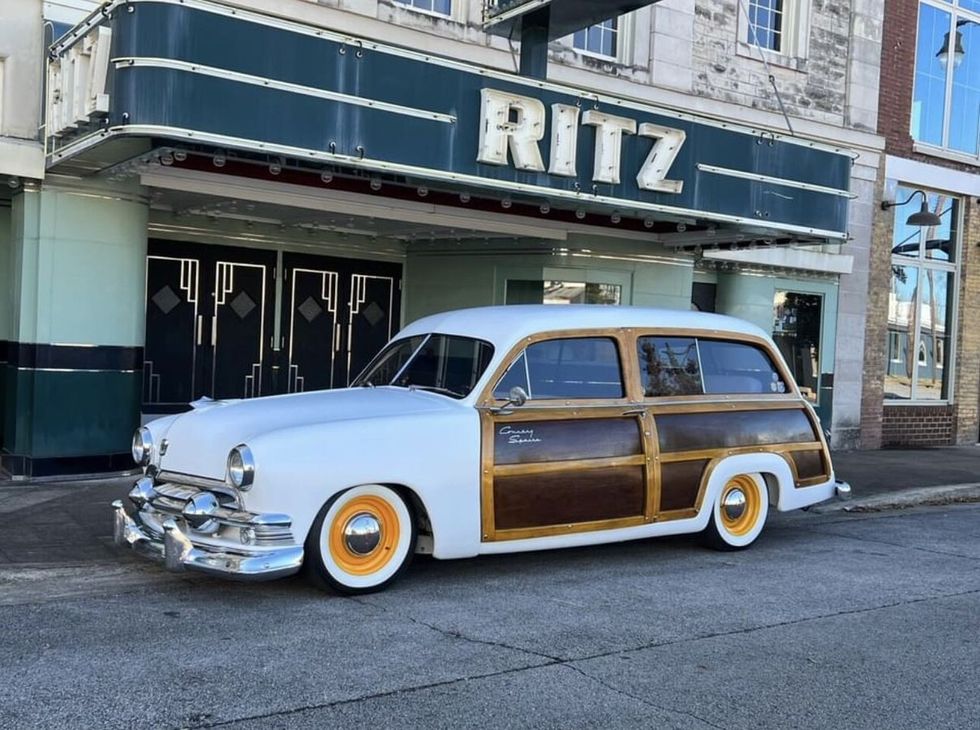
Everybody loves a classic woodie wagon! This two-door 1951 Ford Country Squire wagon still sports its original wood paneling, not that fake plasticky stuff seen on the more modern “wood” wagons. The seller states it is a fresh build that has only been driven 500 miles. A 350-cid Chevy Vortec Engine is hidden under the hood. Tasteful modifications include a Fatman Fabrications front end, an 8.8-inch rear end, power steering, four-wheel power disc brakes, and an all-new interior.
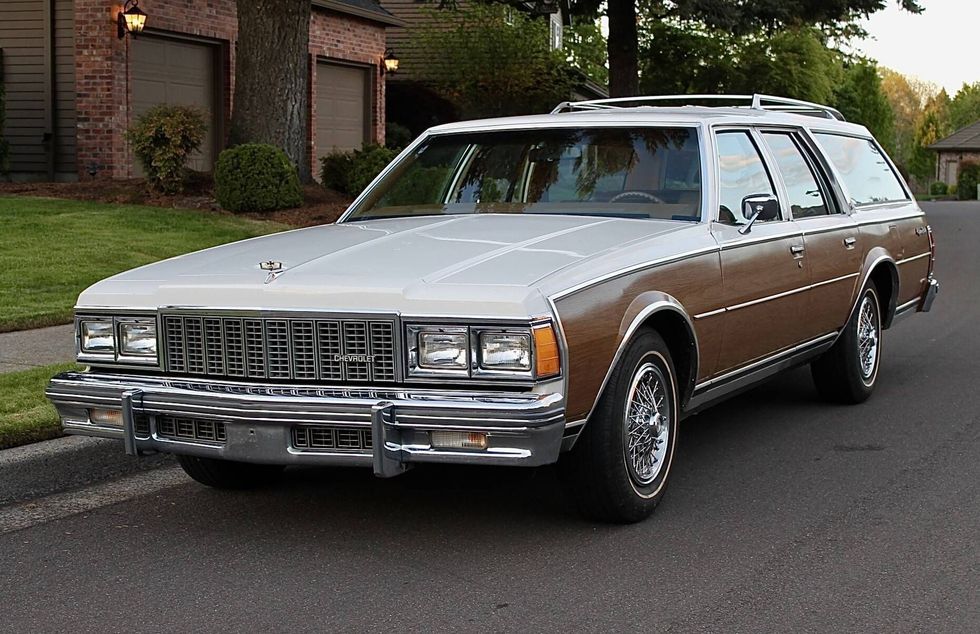
As stated in the auction listing, here’s a family hauler that would draw envious glances from Clark Griswold, this 1979 Chevrolet Caprice Classic Station Wagon is believed to be in original condition apart from maintenance and service requirements, according to the selling dealer, who acquired the woodgrain-trimmed wagon through an estate sale. There’s a 350 V8 under the hood and the seller notes service within the past few thousand miles has included new brakes, a new water pump and radiator, valve cover gasket, muffler, and more. Click here to see the full auction details.

“Experience the epitome of vintage charm and modern performance with the 1964 Mercury Colony Park, a California wagon that's been meticulously restored and upgraded to perfection. Underneath its classic blue exterior adorned with wood paneling lies a beastly 390-cid V8 engine, now equipped with a Holley Sniper EFI system for improved fuel efficiency and smoother power delivery. Paired with an automatic transmission, this wagon delivers a driving experience that's as effortless as it is exhilarating.”

This beautiful Brookwood underwent a professional frame-off custom restoration. It’s a restomod of sorts, still sporting its classic looks while implanting some modern creature comforts and technologies. It’s powered by a 480 horsepower LS3 engine paired with a six-speed manual transmission, for starters. Cruise to the classified to see more photos, plus the full list of custom goodies included in this immaculate 1959 Chevrolet Brookwood Nomad.
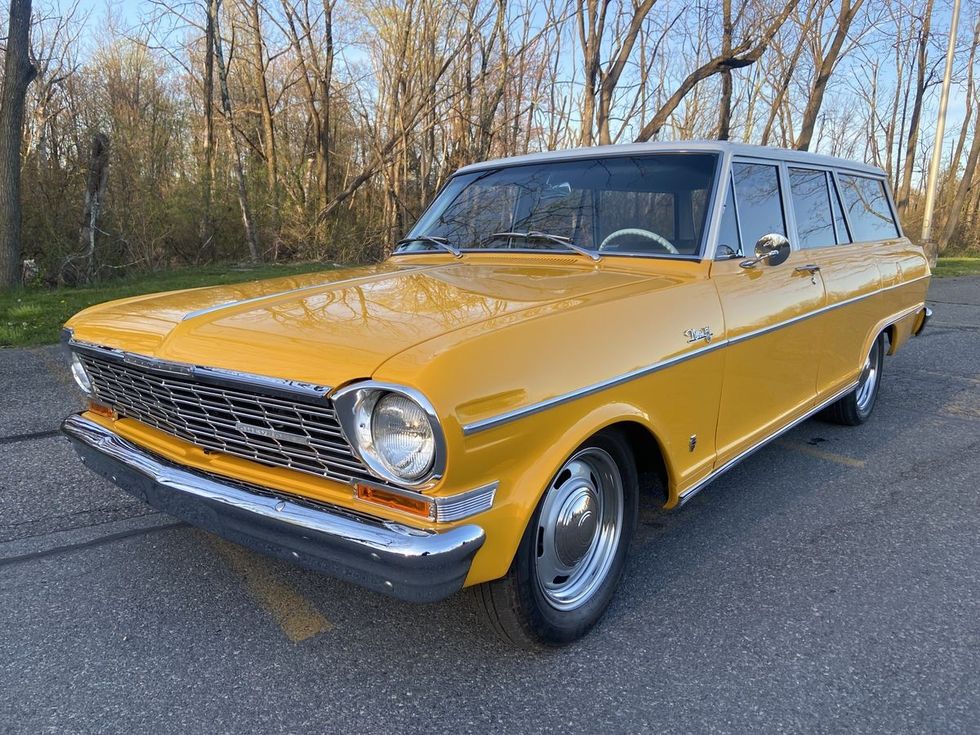
You’ll be hard-pressed to find a classic wagon exactly like this one-of-a-kind 1964 Chevrolet Chevy II Nova. Described as a mild restomod, this station wagon has just 1,000 miles accumulated since its frame-off restoration. The seller states that everything has been done on this car and it “rides, drives, and handles way better than you would expect; straight down the road with no shimmies, shakes, or vibrations.” The craftmanship on this V8-powered Chevy wagon is described as “simply spectacular.”
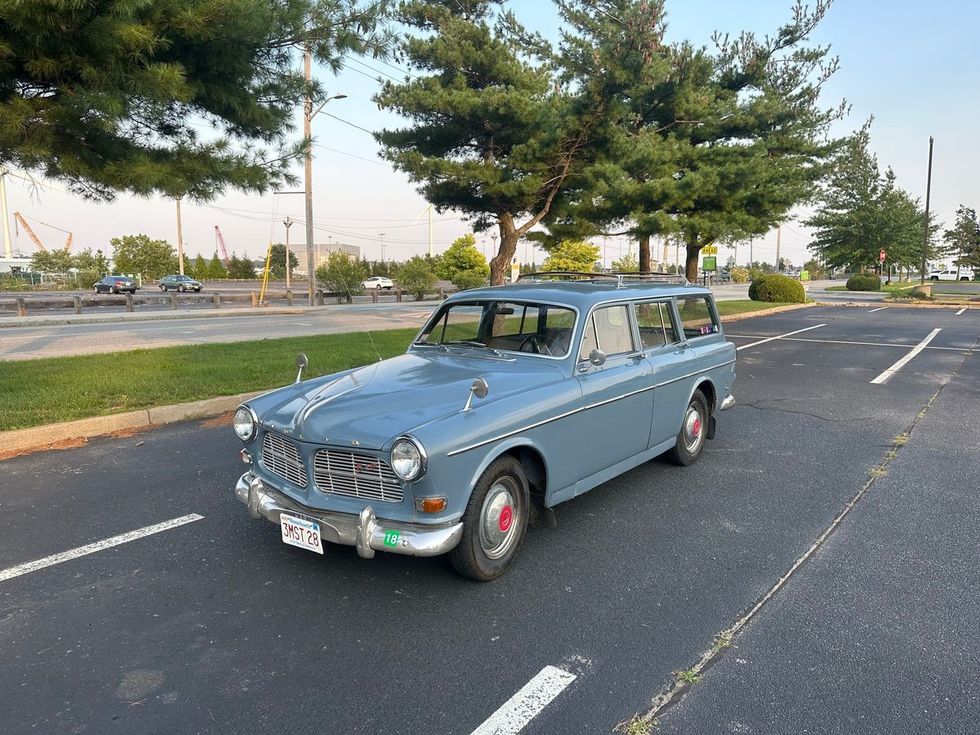
Volvo wagons are getting hard to come by, especially the 1960s-era cars. The seller states that this two-owner, mostly original 1963 Volvo 122S B22 was used as a daily commuter until a few years ago, has been regularly serviced, and is in good running condition with a recent fuel system overhaul. The original exterior does have some blemishes and surface rust, but the seller assures that “With a fresh paint job, she would really turn heads!”
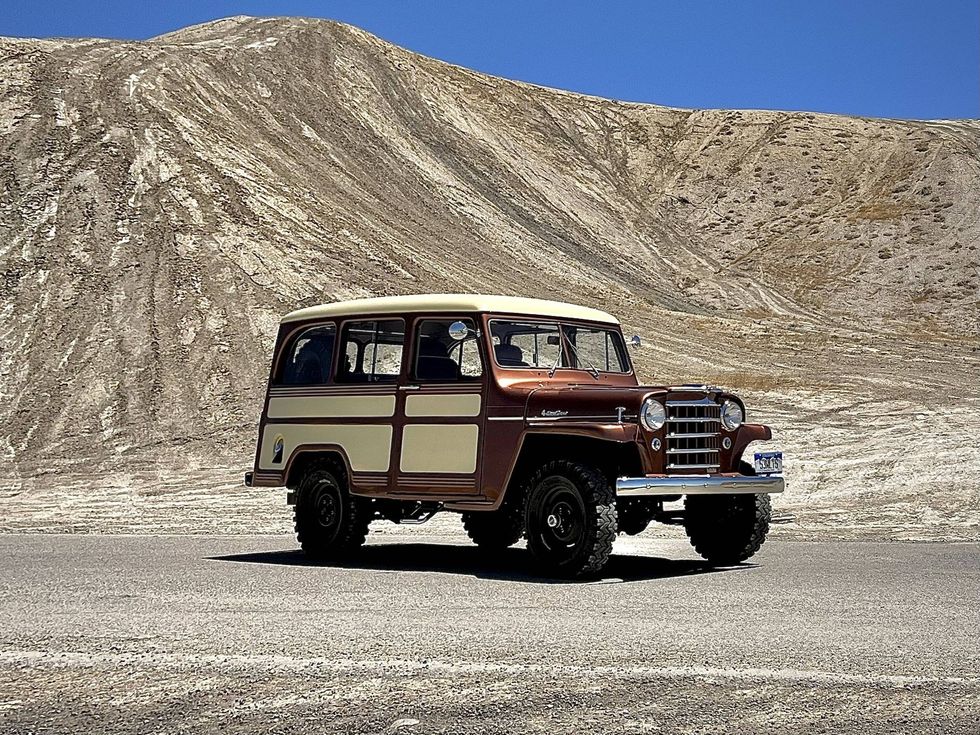
“There are refurbishments and restorations, and then there’s the kind of treatment this 1953 Willys Station Wagon has received. The work is described as a minutely detailed body-off restoration that has left the wagon in better-than-factory condition. Among the many non-production upgrades said to have been performed on this Willys are heated leather seats, a lamb’s wool headliner, a Pioneer audio system with Bluetooth capability, map lighting, and USB charging ports. The Willys is reported to have a replacement F-head engine of the same year and displacement, now rebuilt, and the wagon is described by the seller as free of rust.”

A muscle car in wagon form is what dreams are made of, especially when talking about the second-generation Chevrolet Chevelle SS. This example, a Placer Gold 1971 Chevrolet Chevelle SS Wagon, gets its power from a rebuilt 402 cubic-inch V8 producing 350 horsepower paired with a T-10 4-speed manual transmission geared with a 10-bolt rear end, plus other great features.
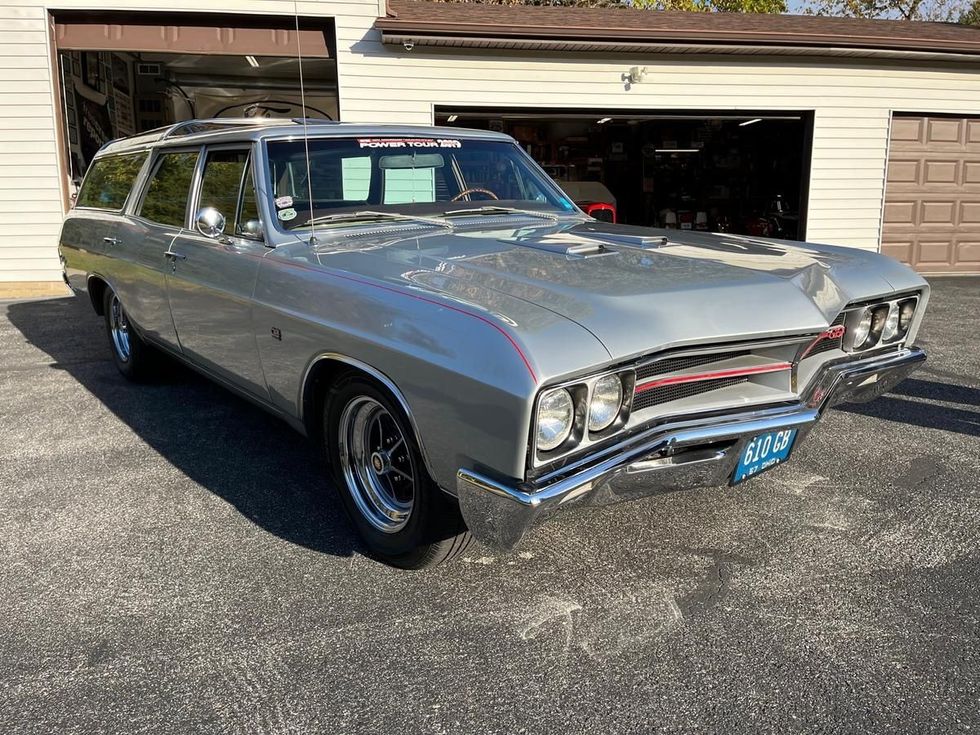
The sky roof (or panoramic roof) on this 1967 Buick Sport Wagon GS adds to this classic car’s luxurious feel. The seller states it is powered by a 350 cubic-inch small-block topped with four-barrel carbs and a Star Wars-style air cleaner. The wagon is described as rust free and ready to drive.

According to the seller of this custom 1956 Ford Parklane Two-Door Wagon, it is so clean that you can “eat off the door jams and spare tire well.” The mild custom sports a 312 cubic-inch V8 paired with an automatic transmission, plus loads of other goodies, including a custom interior. Take a close look at the photos supplied in the Hemmings Marketplace classified listing.
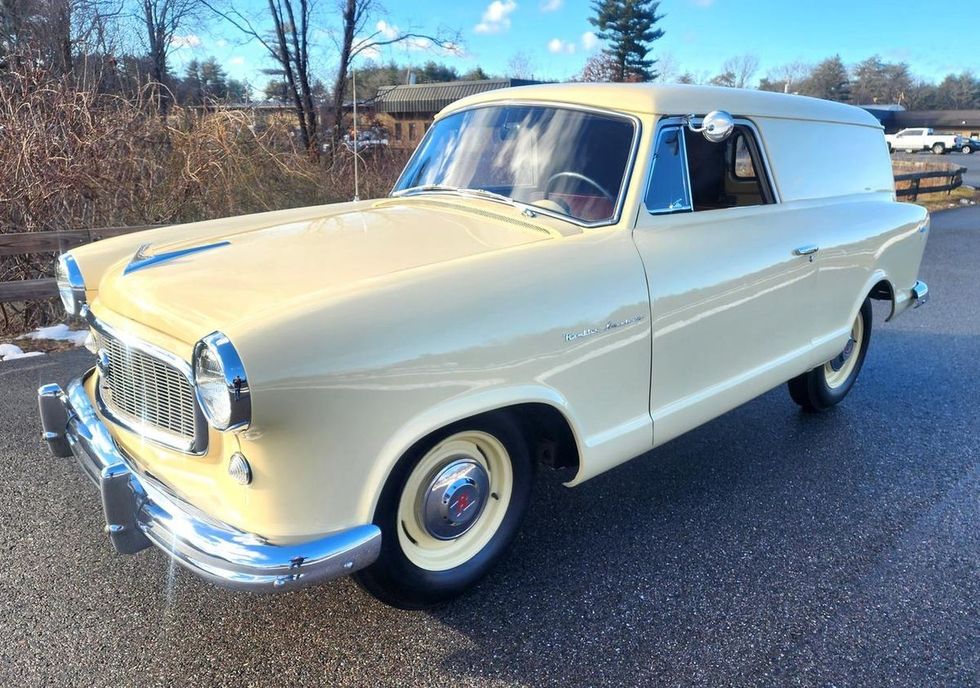
This extremely rare wagon is just one of only three examples produced, and the seller confirms that they do have the production records as proof. Previously owned and restored by the founder of the AMC club of America, the 1959 Rambler American Deliveryman Panel underwent what is described as an exceptional nut and bolt rotisserie restoration just a few years ago. It’s powered by an inline-six engine backed by a three-speed manual transmission, and the engine bay, among other details, is described as stunning.

The classic Chevrolet Bel Air embodies the American Dream of the late-50s, and its V8 engine signifies the era of American muscle. This elegant wagon is offered with an automatic transmission for easy cruising. The seller also states that the 1957 Chevrolet Bel Air is equipped with air conditioning, its classic AM radio, power brakes, and power steering.

If you’re searching for a wagon that will stop passersby in their tracks, look no further than this flame-adorned 1950 Oldsmobile. Under the hood you’ll find a powerful 5.7L Vortec 350 cubic-inch V8 paired with a smooth-shifting four-speed automatic transmission. The seller states, “this Oldsmobile Wagon is not just about looks and performance, it’s also equipped with a range of features designed to enhance your driving experience.” Get the full details here.

This unrestored 1959 Plymouth wagon shows 78,800 original miles on the odometer. The 318 polyhead Mopar engine is topped with a Holly two-barrel carburetor and exhales through a dual exhaust system. Don’t let the main photo of this beautiful machine on a trailer fool you: The seller states that the car is in survivor condition and it drives without issues. Check it out.

This two-door, six-passenger, V8-powered 1958 Edsel Roundup wagon is described by the seller as a no expense spared custom. The customizations were completed by its owner, Frank Montelone, alongside his long-time friend, the legendary George Barris of Barris Kustoms, which makes this custom wagon an incredibly rare find.
There are more wild wagons where these came from. As of this writing, there are around 50 classic wagon listings on Hemmings Marketplace. Take a look!
Ray pile was a part of the immediate post-World War II generation of hot rodders. During the war, he was a waist gunner in Boeing B-17 Flying Fortress bombers attacking Nazi-occupied Europe and afterward he returned to his home in Southgate, California. This is his car, the Pyle Special. Not much is known about its life before Ray got ahold of the Ford. It was just one of millions of Ford Model A’s produced for 1928-’31.
Just two years after the end of the war, an uncle got him set up running a gas station. That’s when the roadster comes on the scene, and with it, Ken Eichert, the father of current owner Chris Eichert and son of Ray’s benefactor-uncle.
Image courtesy of Chris Eichert
A mild-mannered, full-fendered roadster most of the time, one weekend each month the Pyle Special would transform into a race car bent on going as fast as possible on the dry lake beds northwest of Los Angeles.

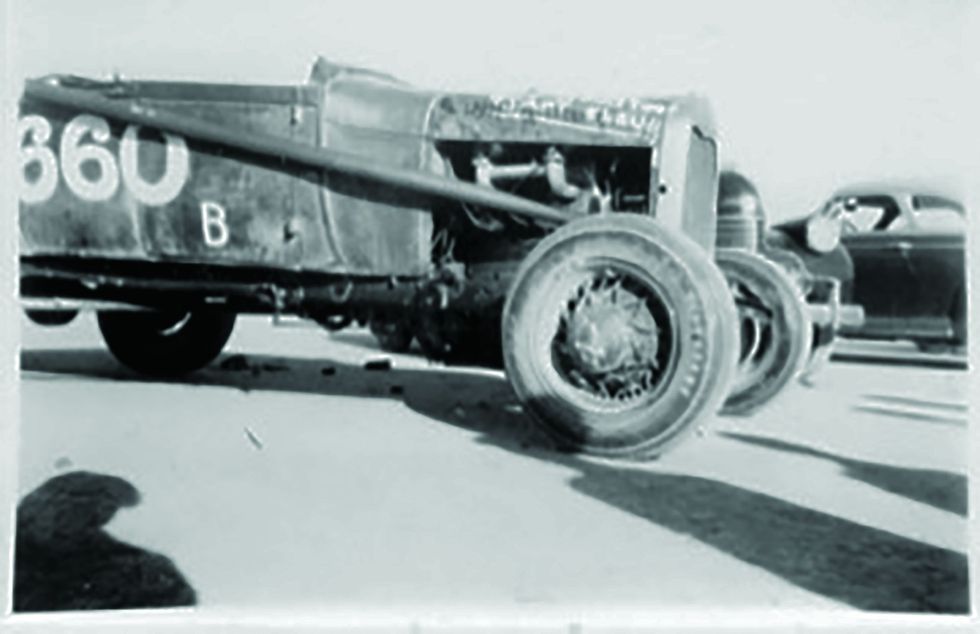

“Ray was my dad’s cousin on my grandmother’s side,” Chris says. Ken had survived a bout with polio earlier in life and was prevented from participating in most sports because of a bad leg. He discovered an outlet in the machines found at his older cousin’s shop and as an honorary member of his car club, the Gaters (note the intentional misspelling as a nod to Southgate).
“My dad was very active with Ray’s roadster. He tore it apart, worked on it, took off the fenders and installed the bomber seat for Ray to race on race day. From 1947 to 1949, Ray was going to the dry lakes with the Gaters, and the roadster was actually a dual-purpose vehicle: it ran full fendered on the street and was Ray’s get-around car, his family car, and then he would race it every month when they had a meet.”
The late hot rod historian Don Montgomery was adamant that the immediate post-World War II years represented the only pure expression of the hot rod: a true street/strip car that was driven by its owner/builder for transportation Monday through Friday and was stripped for racing on the weekends. Postwar racing for hot rods in Southern California circa 1946-’52 was largely either “the lakes”—meaning the dry lakes of the Mojave Desert, mostly El Mirage, or drag racing. At the tail end of the period, drag racing started to become formalized, on closed strips often comprised of aircraft runway infrastructure built for the war. Before that, acceleration contests were an informal activity done on public roads and facilitated by the popularity of drive-in restaurants.
Photo by Todd Ryden
This is the engine Ray raced at Santa Ana, originally built for him by Cook’s Machine Shop. Chris says it’s been drilled for full-pressure oiling, has had large valves installed, and had an unmarked but “really big” camshaft installed. It has since had fresh pistons and a milder cam installed. The Stromberg 81 carburetors are a smaller version of the 97, originally intended to equip 1937-’40 Ford 60-hp V-8 engines.



That three-faceted nature of postwar hot rods made them special and keeps them relatable today. Most roads in America are still suitable habitat for 1940s cars—whether they were new cars from 1947 or have been updated to 1940s technology. That ‘40s technology makes for a particularly satisfying operator experience—just automated enough not to be intimidating, but satisfyingly mechanical and interactive in all other respects. The sights, sounds, and smells are pure automobile, and the industrial design of every component says, “built right.”
Small wonder Chris decided to take the roadster back to how Ray had it. It even does a lot to explain why Chris’s father bought it off Ray in the mid-1960s, over a dozen years after it was last raced. It was far out of step with those times. It didn’t even have a flathead V-8. Ray had built the car to use four-cylinder power and its final engine had been a Model B unit, the 1932-’34 successor to the Model A four-cylinder and incorporating many of the popular modifications already done to make Model A engines suitable for high-performance applications.
“The motor that Ray raced with at the dry lakes was a four-banger with a two-port Riley,” Chris says. The Riley was an F-head design, or what the British and Harley-Davidson enthusiasts call “intake over exhaust,” meaning the exhaust valves retain their stock location in the block, but the intake valves are relocated overhead and actuated by pushrods and rocker arms. Even in flathead form, Model A and B four cylinders were respected for their off-the-line performance while the Ford V-8 was capable of greater top-end speed. An OHV or F-head conversion on a four-cylinder usually meant it was capable of keeping up with a flathead V-8 even at those higher RPMs. Chris would love to someday replicate that engine, which he and Ken discovered in derelict condition shortly after Ray’s death in 1987 and deemed unsalvagable.
The roadster’s final outings were to what was then Santa Ana airport. The first modern dragstrip began operation there in the spring of 1950 and Ray quit driving the Pyle Special about 1951. It didn’t move again until 1964 or ’65, when Ray sold it to Ken, who in turn held onto the car more as a keepsake than an active project. As a child, Chris would sneak into the freestanding garage where it was stored and sit in it and later it would provide plenty of father/son bench racing and swap-meet parts buying episodes.
Aside from one brief-but-memorable ride, the car sat in storage until 2007. By that point, it had suffered a couple indignities: its engine sold off to a friend’s speedster project and one fender and splash apron were brutally disfigured in a freak accident involving a large stack of tile.
“My dad was getting older. I told him I wanted to get the roadster going and he told me to bring it over. I took it completely apart and I cleaned off decades and decades of dirt. I actually saved some of it, thinking it was probably El Mirage dirt. I have two cigar vials full.”
That cleaning and disassembly venture was a crash course in postwar-era hot rodding.
Photo by Todd Ryden
The front axle was dropped back in the 1940s and installed on the roadster circa 1950. To further lower the roadster, the spring eyes were reversed on both the front spring and in the rear.




“Nothing was precisely done. It was a real trip to see what hot rodders did back then and how they put stuff together. It truly was like going back all those years. Then seeing how it evolved in the late ‘40s into the ‘50s in old pictures, as it became what it is today.
“I ended up buying the motor back from the friend with the speedster. I told him what we were going to do, and he did not hesitate to sell it back to us. I had a friend of my dad’s rebuild the motor.”
Chris then re-installed all the speed parts that had come from Ray, plus a few his father had collected along the way, notably twin Stromberg 97 two-barrel carburetors on an Evans intake and a Mallory dual-point distributor. Chris also discarded Ray’s rear-only mechanical brake setup for 1939 Ford hydraulic brakes contributed by a friend of his father. “That’s the kind of friends my dad had,” he says. “All his hot rod friends knew about the roadster and when I told them I was working on it, they gave him stuff.”
Once the roadster was going, there followed a whirlwind of father-son activity with it, culminating in the twin delights of a Hot Rod Magazine feature story of the still-in-primer roadster, and Ken getting to drive the roadster at El Mirage for the first time ever. Then, Ken died in 2011 and the roadster took another hiatus.
“After Dad died, it sat. I could not get the motor running for snot. I took it to three or four old guys who worked on old Model A’s, hot rod guys, they couldn’t get it running. I kept spending money to no result, so I mothballed it for another 10 or 12 years, from 2011 to about a year or so ago.”
Photo by Todd Ryden
“It’s a rattle can, but the coolest rattle can you could ever be in. I still drive it and have memories of my dad and wish he were there and could share the moments. Even though I didn’t know Ray, I think of him. He got this up to 116 mph and that’s a feat. I’ve probably gone no faster than 65 mph and it scared me, I couldn’t imagine doing 116.”



For help, Chris turned to a fellow member of the revived Gaters club, welder/fabricator and hardcore enthusiast of midcentury Americana, Randy Pierson.
“He’s got a period army tent, a period camp stove, he tows his roadster with a ’49 Merc four-door. The body on his roadster is all handmade. He is the pinnacle for our group who keeps us true to that era and what we do and what we don’t do and what we put our signature on as a club as far as being period correct.
“He did some body work (but he said it was one of the nicest Model A bodies he’d ever worked on). It was all hand welded, hand hammered, hand finished. We stripped off down to the color that was consistently across most of the body. He rewired it with cloth wire as it would it have been in period, and he really was meticulous to getting it back to as it was in 1947. We looked at pictures. He kept what he could keep and mimicked what needed to be done to make it true to its 1940s life.”
Also mimicking its 1940s life was the scramble to get it ready for race day. In this case, the West Coast iteration of The Race of Gentlemen, which is not a beach race but is instead held at Flabob Airport in Riverside, California, in the style of the original Santa Ana drags.

Although it still rides on a Model A frame, at some point the k-shaped crossmember from a 1932 Ford was installed, which stiffens the chassis slightly and provides built in mounts for the later transmission and floor pedals. Ray apparently lacked the tools to shorten the driveshaft, however, which pushed the engine and transmission forward slightly. During the rebuild, Chris and Randy moved the radiator back to its stock position to run an original-style hood.
Photo by Todd Ryden
“We found a bomber seat and just a couple weeks before the race, Randy had started to work on the motor to get it running and he too could not get it running right. He pulled it apart and he’s not a motor guy, but he knows enough, and one of his neighbors is an old hot rodders. We changed out the 97s to 81s because the 97s were a lot of carburetor for that little banger motor, especially in duals. Then he still had a hard time. We took out the cam, put in adjustable lifters, and at the very last second, we were trying to find a different cam for it, because we figured there was something going on with the cam. I asked a buddy if he had anything to go in my roadster and he sold me a cam and I sent all that up to Randy, who worked on it feverishly for a week to ship it back down for the races. He got it running and when he got to drive it down the street, he was surprised. ‘This thing has got it. This thing scoots.’ It runs really strong.”
That strong running paid off in a lot of fun at TROG West, giving truth to one more of Ken’s old stories.
“My daughter has a video of me racing a T/V-8 and I pass the camera behind the T, but by the time I get to the finish line, I’ve beat her. It brings back memories of my dad telling me ‘Yeah, that motor will beat some V-8’s.’ It’s one of those moments, again, of my dad’s stories from all those years ago having proof in their pudding. Those revelations keep happening.”
What’s next for this old racer? “I never did get it registered when I moved from California to Texas,” Chris says, “but I am going to get it registered.”
Hopefully, it will be back on the streets soon, paying tribute to that triple-threat nature of hot rodding’s golden era.
Photo by Todd Ryden
“We reproduced the tailpipe that’s on it from pictures. It’s built from 1938 driveshaft enclosures because of the taper they have at one end. When Ray was racing it, that’s one of the things my dad put on it every time, so that’s what we did when we were putting it back together. It’s got a killer, throaty sound to it.”

